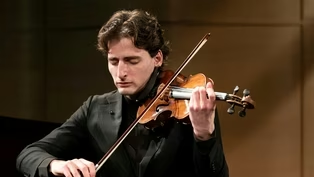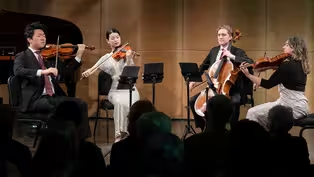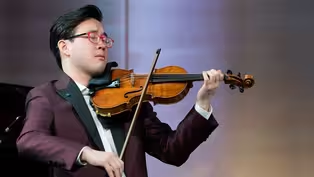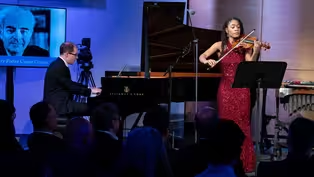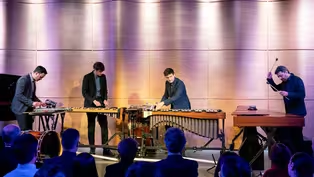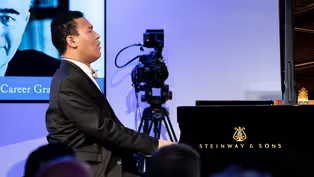
Taking Note — Tommy Mesa
Special | 10m 44sVideo has Closed Captions
Cellist Tommy Mesa's love of music began with his interest in playing drums.
Cellist Tommy Mesa's love of music began with his interest in playing drums. Selecting orchestra class in middle school, he learned violin before picking up the cello. Performing works by Ernesto Lecuona and Debussy on his 1767 cello made by Nicolò Gagliano, Mesa celebrates both his Cuban and French heritage.
Problems playing video? | Closed Captioning Feedback
Problems playing video? | Closed Captioning Feedback
Major series funding for GREAT PERFORMANCES is provided by The Joseph & Robert Cornell Memorial Foundation, the Anna-Maria and Stephen Kellen Arts Fund, the LuEsther T. Mertz Charitable Trust, Sue...

Taking Note — Tommy Mesa
Special | 10m 44sVideo has Closed Captions
Cellist Tommy Mesa's love of music began with his interest in playing drums. Selecting orchestra class in middle school, he learned violin before picking up the cello. Performing works by Ernesto Lecuona and Debussy on his 1767 cello made by Nicolò Gagliano, Mesa celebrates both his Cuban and French heritage.
Problems playing video? | Closed Captioning Feedback
How to Watch Great Performances
Great Performances is available to stream on pbs.org and the free PBS App, available on iPhone, Apple TV, Android TV, Android smartphones, Amazon Fire TV, Amazon Fire Tablet, Roku, Samsung Smart TV, and Vizio.
Buy Now
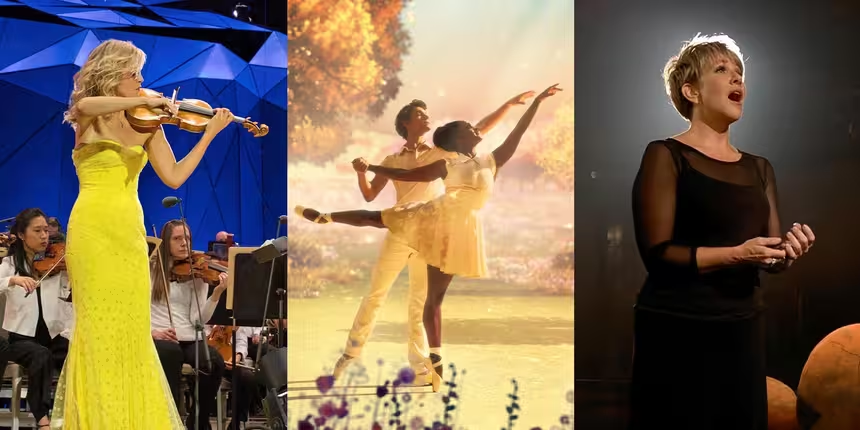
Great Performances Newsletter
Subscribe to the Great Performances newsletter to keep up with the latest full episodes to stream, exclusive content, and more!Providing Support for PBS.org
Learn Moreabout PBS online sponsorshipMore from This Collection
Taking Note is a new digital series spotlighting rising instrumentalists who have received Career Grant Awards from the Avery Fisher Artist Program. Each year, the program awards $25,000 to instrumentalists and chamber ensembles in support of professional music development.
Video has Closed Captions
Following in his brother’s footsteps, Joshua Brown picked up the violin at age two. (9m 3s)
Video has Closed Captions
Composed of violinists Lucy Wang and Hao Zhou, violist Aiden Kane, and cellist Tate Zawadiuk. (11m 54s)
Video has Closed Captions
A profile of violinist Julian Rhee, winner of a 2024 Avery Fisher Career Grant Award. (10m 11s)
Taking Note - Balourdet Quartet
Video has Closed Captions
A profile of Balourdet Quartet, winner of a 2024 Avery Fisher Career Grant Award. (9m 18s)
Taking Note - Njioma Chinyere Grevious
Video has Closed Captions
A profile of violinist Njioma Chinyere Grevious, winner of a 2024 Avery Fisher Career Grant Award. (8m 41s)
Taking Note - Sandbox Percussion
Video has Closed Captions
A profile of Sandbox Percussion, winner of a 2024 Avery Fisher Career Grant Award. (10m 4s)
Taking Note - Clayton Stephenson
Video has Closed Captions
A profile of pianist Clayton Stephenson, winner of a 2024 Avery Fisher Career Grant Award. (9m 57s)
Providing Support for PBS.org
Learn Moreabout PBS online sponsorshipAnd I was absolutely horrible at the violin.
The only reason why I started the violin was because I had a crush on a girl named Sabrina.
And I wanted to be next to Sabrina, but she rejected me.
And so then I started playing cello because I made friends who played cello.
♪♪ ♪♪ ♪♪ ♪♪ ♪♪ I was in the car coming back from a show, and Véronique calls me in the car, and I was stuck in New York City traffic, like on the way from Brooklyn back to Manhattan.
And I saw that she had left me a message earlier and I was like, oh, it's just going to be some event, some fundraiser event.
I call her back and she says, You know, congratulations, you know, we're going to give you an Avery Fisher Award.
And I just start crying.
I mean, like, it was just such an emotional thing because it's there's so much history and such a legacy with this award that it just felt like such a wonderful time, you know, to to have received that.
My sort of love for the instrument of the cello itself was definitely an entirely accidental event.
I was in middle school.
I got there to the first day of class and I wanted to play the drums.
So in my little survey, I actually picked orchestra.
And of course, there's no drums in an orchestra.
So I was really upset.
And so I ended up staying in the class and playing the violin.
And I was absolutely horrible at the violin.
The only reason why I started the violin was because I had a crush on a girl named Sabrina.
And I wanted to be next to Sabrina, but she rejected me.
And so then I started playing cello because I made friends who played cello.
So this cello is made in 1767 by Nicolò Gagliano and is on it's on loan to me from Roger Dubois at Canimex Inc.
When I originally went to Roger Dubois home for him to lay out the instruments that were going to be an option for me to choose, he laid out four cellos and four bows.
And so I would have to pick between those those eight things.
And so of all the cellos, actually, this wasn't the first one that I chose and sound, you know, it's because sound is a little bit strange when it comes to these fine instruments.
Is that under your ear it's very different from what it sounds like out there.
So if you were to stand across the room and listen to this instrument, it's very different from what I'm experiencing.
There was an instrument made by Vuillaume that I instantly was drawn to the sound, and I knew that that was the instrument.
But out there it wasn't projecting as much to the people who were listening to me playing.
And so the feedback was such a great thing because under the ear, this instrument didn't sound like it was really reaching out.
But that was by far the favorite of everyone.
The top register is essentially, you know, it blasts into a hall.
It's an unbelievable sound.
Its got a beautiful middle register, a really robust bottom bottom register.
It's just everything in a cello that I've ever wanted.
So one of the reasons why I picked the piece by Ernesto Lecuona called Malaguena, but also the Debussy, is that both are sort of they're they're part of my heritage.
So my heritage from one generation ago goes back to Cuba.
My dad came over in 1961 with his family, with absolutely nothing, went to Miami.
They started a plumbing company.
And so Ernesto Lecuona, being a Cuban composer, I was just fascinated by his work.
And so I have a best friend named Greg Zelek who actually arranged this music for cello and organ.
And then we re-adapted it for cello and piano.
♪♪ And then the French music... So my my grandfather, who was in Cuba, he actually came from France.
And so I love that this is kind of melding into this sort of heritage collection of pieces that it feels very personal to me.
I'll be playing Debussy's Sonata in D minor, and this piece is very, very special in that it still to this day, sounds experimental, even though it was written in in the 1910s right?
♪♪ And there's so many different things that it allows the cellist to express, you know, ten different types of pizzicatos, ten different types of ways to use the bow in relativity to the bridge.
♪♪ ♪♪ ♪♪ ♪♪ ♪♪ ♪♪ ♪♪ ♪♪ ♪♪ ♪♪ ♪♪ ♪♪ ♪♪ Almost every single note that Debussy writes down there is an expressive marking that goes with it.
So an accent with a dot, accent with a with a dash.
You know, there's so many things and the list goes on and on.
So it's the detail that the cellist has to express in this music, is so wonderful.
But what comes out is this style of Debussy that we all know and love ♪♪ The first movement of the Debussy Sonata Prologue, there is a lot of sort of improvisatory kind of feeling in it, and there's a lot of ornamental figures in the cello line that feel like grace notes, but they're actually written out.
And so you see that a lot in Debussy's music, where it creates these colors on the page, it's just black notes, you know, like very quick notes.
And I love that how that creates this idea of, you know, color without it actually indicating so.
♪♪ So Malaguena, you know, is sort of dance of Malaga and that is definitely, you know, this this kind of music is known all over the world.
You know, it's it's one of the most recognizable tunes from the Cuban and Spanish kind of roots.
And I just I love that that it's adapted for the first time ever for cello and piano in this format.
So this is a little bit of a premiere in a sense.
♪♪ The pianist I'll be collaborating with is Ilya Yakushev, and we have performed all over the country together in many of on many different occasions as a duo.
We've covered lots of repertoire, and I just I'm so glad that he was able to make it.
He had two free days here in New York City during this time period, and it is absolutely coincidental.
So it's it's wonderful.
♪♪ I do love teaching.
And I recently was hired at the Manhattan School of Music.
I've always loved mentoring and just helping young cellists out.
And so I, you know, for the last several years have gone around and done masterclasses at different universities, conservatories, colleges.
And finally I get to build my own studio and in a place that attracts wonderful students at Manhattan School of Music.
So that's really exciting.
You know, I, I adore that now I can have a base somewhere, still perform and still go off and do whatever I have to do on stage, but also apply what I learn on stage to help these students ♪♪ [Applause] Theres maybe 10 to 15 different pizzicatos that the Debussy expresses on the music.
Some have hairpins going to a piano, some are, some have accents with a dash, some have accents with a dot.
I mean, there's so many different ways to play this music, but it all feels very stream of consciousness.


- Arts and Music

Music for the Christmas season featuring the Choirs and Orchestra of St. Olaf College.












Support for PBS provided by:
Major series funding for GREAT PERFORMANCES is provided by The Joseph & Robert Cornell Memorial Foundation, the Anna-Maria and Stephen Kellen Arts Fund, the LuEsther T. Mertz Charitable Trust, Sue...
